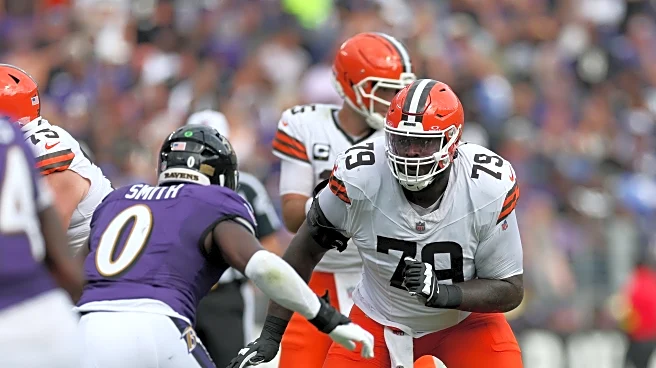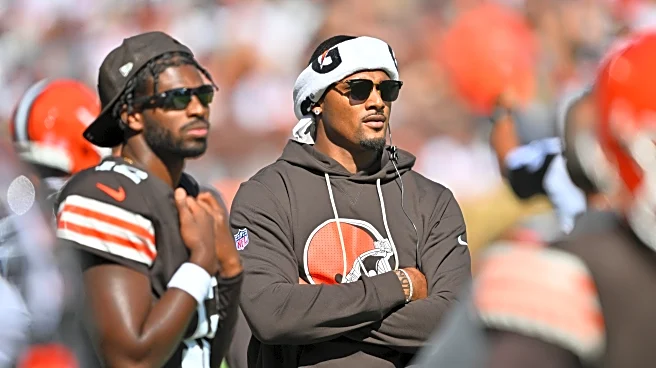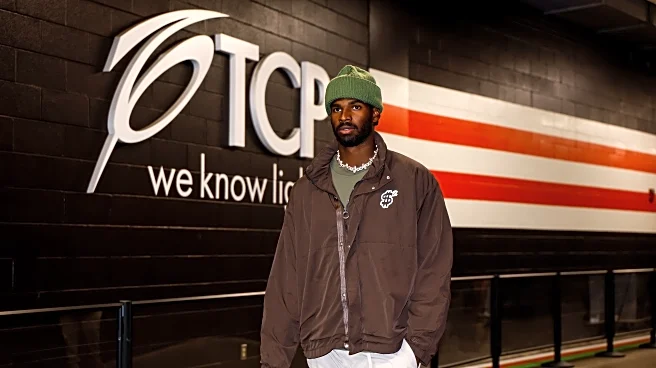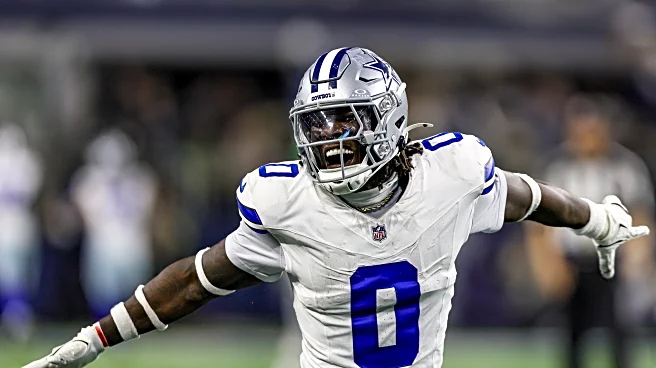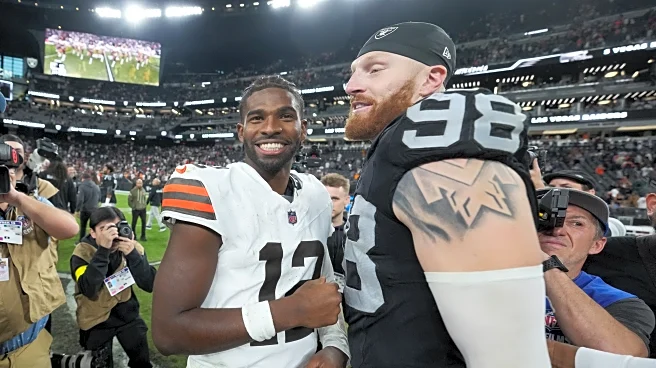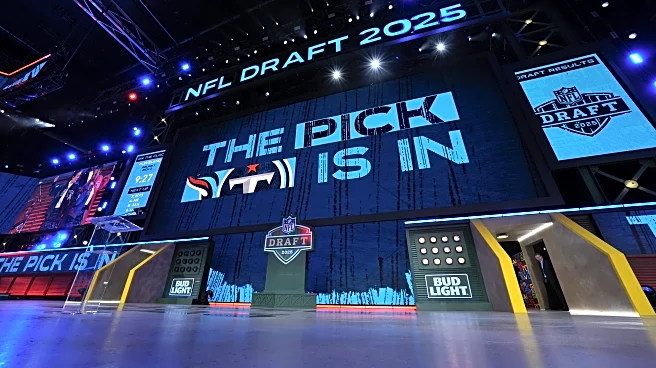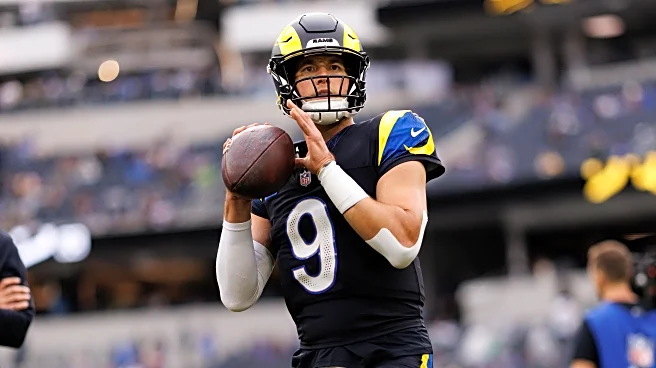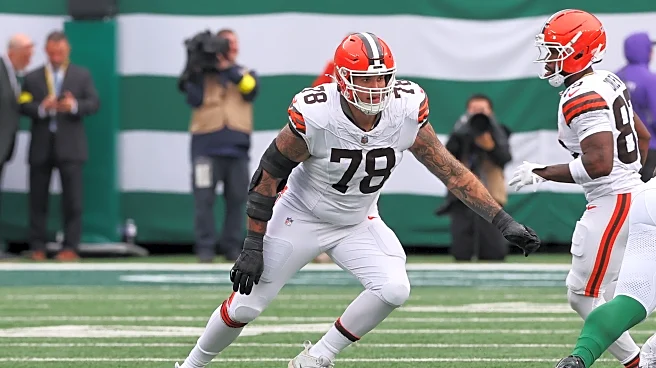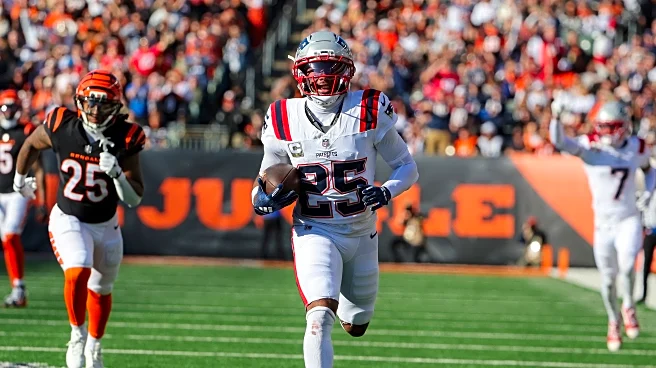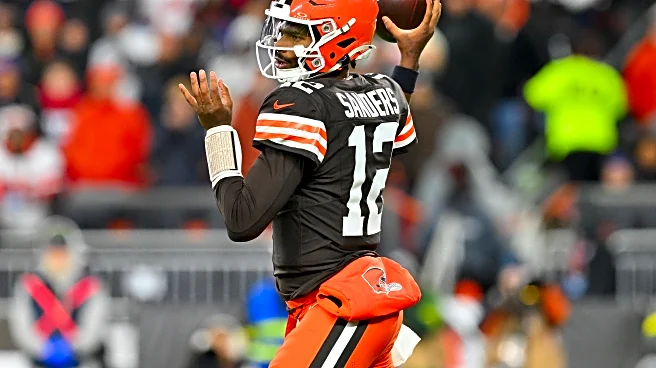With every good musical band, there are levels. It is not displayed to their endearing music lovers, but it’s there.
The lead singer is the showman, the leader, so to speak, the one everyone looks to so that their fans are satisfied. The drummer is the crazy one, the risk taker, and the most physically gifted. The keyboard player is the tactician and exudes creativity and expects perfection. The lead guitar is the smart one, the craftsman, and most expressive. And the bass guitar player is the quiet
one, the least noticed, and the main team player.
RELATED: OFFENSIVE LINE LIMITS OPTIONS FOR OFFENSE
All of this translates to a football team like the Cleveland Browns, precisely, along the offensive side of the ball.
The quarterback is the showman, the running back is the crazy one, the receivers are the tacticians, the tight ends are the most expressive, while the offensive line is the unsung, the team players, and the least noticed (until they commit a foul during a game).
The truth is, every single aspect of the offense is dependent on how the offensive line plays. Every run, every pass attempt, every snap, and every series. If the offensive line is bad, the offense does not move the ball.
Incompletions go up because the quarterback doesn’t have the time to throw. Rushing averages are low since the offensive line cannot open holes. Interceptions increase. So do sacks and pressures and other related stats with words like hurries and knockdowns. First down conversions suffer. The points seen on the scoreboard decrease.
And the ability to add wins to the standings becomes more difficult.

Every offensive line in football isn’t a guard, or a center, or a tackle, or the extended position of tight end. Every offensive line is a group. A unified assemblage of five guys. Yes, any of the cinco can be recognized for their achievements, receive accolades, and become an independent being come contract time. But they are a group. A collection that needs the cohesiveness and assistance of the other four men.
A left guard will work with a left tackle somewhat, and certainly with the center, but this guard also works in concert with the other guards, with pulls, stunts, coverages, and schemes. If the right guard is pulling on a running play, the left guard must know where to shift his defender in front of him so as not to interfere with the flow of the play and everyone else’s blocking assignments.
Offensive tackles are the cornerstone of any running play to the outside, but are basically on an island to themselves on passing downs. Their job is to move the EDGE rusher as far deep as they can so that the pocket remains intact along the outside parameters. Rarely is a guard able to help with a tackle’s blocking since he has his own defender, or a blitzing safety or linebacker, to worry about.
The Browns’ offensive line has basically had the same lineup since 2020, when the pandemic hit. Except for LT Jedrick Wills, the other four guys have been together for years. They know each other. They know what to expect from their group partners and how to communicate effectively without saying too much.

RT Jack Conklin, RG Wyatt Teller, C Ethan Pocic, and LG Joel Bitonio have been the hallmark of the Browns’ offense. In 2022, Pro Football Focus (PFF) ranked this group, plus Wills, #2 at season’s end as the best offensive lines in the NFL.
Earlier this year, Dawand Jones was inserted at left tackle while the remainder of the Browns’ offensive line remained identical.
But attrition affects every football squad. Players at various positions get injured, are ruled out for several games, if not for an entire season, and other guys must fill in. Sometimes, the backup will become that gem waiting to be discovered and ends up keeping his starting role. Other times, the young drafted player has to be inserted, and soon it becomes clear that he is not ready for the next level. More development is needed, or a new scenery with a different team, or just can’t cut it in this league, and eventually, the phone calls to his agent cease.
No more direct deposit funds, or cheering crowds, no more autograph requests, or that familiar sweaty grassy smell that permeates the sport of football.
Which circles back to the Browns. This season, the Cleveland offensive line has had its problems.
RELATED: 2025 OFFENSIVE LINE PRESEASON RANKINGS
As of Week 12, the Browns have used seven different offensive line combinations. Every offensive line is not just five guys, but one unit that has to rely on each other and gain continuity and trust. A player must learn the tendencies of his working “neighbor” to thrive.
Sacks continue to be at high numbers. Last season, the Browns allowed the second-most sacks with 66. This year, with six games remaining, Cleveland has allowed 30 sacks and ranked as the #10 most. A good portion of that is attributed to LT Cam Robinson. Do we agree that left tackle is the most important position on the offensive line? For the Browns, this is a liability each game. Before Robinson, both Jones and backup Cornelius Lucas didn’t do much better.
The Top-4 offensive lines so far this year are the Philadelphia Eagles, Denver Broncos, Indianapolis Colts, and Buffalo Bills. What do all of these clubs have in common? No, it’s not a trick question, and you don’t have to write the answer on the top of your Nikes for quick reference. They are all really good ballclubs with winning records. Good teams possess great offensive line groups.
Going into Week 12, the Browns’ offensive line was ranked by (PFF) at #30.
Here are the individual Browns offensive line PFF grades at this point in the 2025 season:
Joel Bitonio – 71.3
Jack Conklin – 57.3
Teven Jenkins – 86.5
Dawand Jones – 32.8
KT Leveston – 44.7
Cornelius Lucas – 42.9
Ethan Pocic – 60.7
Cam Robinson – 44.5
Wyatt Teller – 61.7
Luke Wypler – 30.3
Zak Zinter – not enough snaps
Let’s be very fair: no quarterback in this league is going to have good stat numbers as long as they are being protected by one of the lowest-ranked offensive lines. And the offense will spit and sputter on game days. Sound familiar?
This year’s offensive line has played pretty badly. And many are in the last year of their Browns contract.
What should be done about this group? Part of the issue is the “Nick Chubb Syndrome.” We, as Browns fans, love these guys, even though their talents may have seen better days, and a separation just might be in the near future. We don’t want to accept that their skills are diminished, and perhaps the franchise doesn’t want to cough up huge chunks of cash for sub-par production.
Here at Dawgs by Nature, we wanted to get together some very good minds who have some sort of Browns affiliation to discuss what the team should do about the offensive line after this season has concluded.
None of this discussion will focus on next year’s NFL draft or any players the Browns should be interested in during the free agency period. Just straight talk about the current situation of the offensive line, who is on this roster, and what the options are going forward.
——————————————————————————————————————————————————————————

RT Jack Conklin
Age: 31
2025 cap hit: $5.63 million
Jack Conklin has a revised contract with the Browns that makes him a free agent in 2026 instead of 2027. The restructured deal pays him $10 million for the 2025 season, with up to $2 million in incentives, and removes one year from the four-year extension he signed in 2022.
Analyst: Kristy Acuti
Administrator: Browns Fans Only (BFO) Facebook fanpage; Sports Informer: Cleveland 13 WCTU; Co-host: TMDE Sports podcast; Co-host: Jersey Chasers podcast
Q: Should the Browns sign oft-injured Conklin to a new extension?
I’m thinking that for the right price, we could keep Conklin on, on a year-to-year basis. I personally feel like he’s injury-prone, even though he did start 12 games last season. Jack’s been hit or miss this season already.
So, I think signing him to a one-year deal, and picking up a great offensive tackle in the off-season or draft would be smart to have as maybe a backup or even starting in front of Conklin. I like Conklin a lot. I think he’s still got some gas in the tank, just worried about his knees.
——————————————————————————————————————————————————————————

RG Wyatt Teller
Age: 30
2025 cap hit: $12.45 million
Wyatt Teller inked a four-year extension in 2021 for $56.8 million. It expires this year. He has publicly stated he prefers another extension and would like to end his career with Cleveland.
Analyst: Kenny “Mac” MacDonald
Ottawa Browns Backers
Q: Teller has expressed his desire to sign one more extension and retire with Cleveland. His deal is up after this season. If you were the GM, would you re-sign him, and if so, for how many years?
The offensive line needs a change. Whether in sports or business, the same principles can apply, and one lesson I learned comes from a classic model used in team-building: Bruce Tuckman’s stages of group development. The Browns’ offensive line has gone through a full lifecycle over the past four seasons, and it mirrors Tuckman’s model almost perfectly. What began as a talented unit coming together under Cleveland head coach Kevin Stefanski quickly moved through the classic stages: the “forming of a new identity” in 2020, the “storming phase” as injuries and inconsistencies tested the group, the “norming stretch” as roles solidified, and ultimately the “performing stage,” when this line operated as one of the best in football.
But like every high-functioning group, the “adjourning stage” eventually arrives—the moment when it’s time to break things apart and start over. At the end of this season, that’s exactly where the Browns will be. Three of the five starters are headed toward contract uncertainty. Joel Bitonio is nearing the end of a Hall of Fame-caliber career, Conklin is recovering from another significant injury, and Ethan Pocic’s long-term future is unclear. This isn’t a situation where Cleveland can simply patch things up. It’s a near-complete reset.
That means the Browns must now shift into building a brand-new “Forming” stage for the next iteration of their offensive line. There is some youth, size, contract stability, and scheme versatility waiting in the wings, depending on how the coaching staff evaluates its developing players. Still, Cleveland needs a veteran tone-setter to help guide the line through its next evolution. If I’m choosing only one expiring lineman to stay and lead this transition, it’s Wyatt Teller.
Teller is 30 years old and is in the final year of the four-year, $56.8 million extension he signed in 2021. He has publicly stated he wants to retire in Cleveland, perhaps a hometown discount? While his performance has been up and down the last two seasons, Teller remains a violent, high-impact run blocker and one of the emotional engines of the offensive line.
Re-signing Teller isn’t about nostalgia. It’s about stabilizing the next phase of the Browns’ offensive line while maintaining a physical identity during a period of transition. It’s also about leadership, especially as the team prepares for life after Bitonio. Teller’s next contract shouldn’t – and won’t -, match his previous $14.2 million per-year average, but he still holds real value as a bridge between eras.
A reasonable extension would be two years at around $18–20 million total, with $10–12 million guaranteed and a structure that keeps the first-year cap hit manageable. This rewards Teller for what he continues to bring, protects the team from long-term risk, and aligns with his desire to remain a Brown for life. More importantly, it provides continuity during a period when the offensive line is undergoing significant change.
Keeping Teller accomplishes several things at once: it maintains leadership during the new Forming stage, preserves a core of physicality in the run game, offers stability for younger teammates, and brings needed toughness and attitude to a line that will soon be reshaped. In short, if the Browns are only retaining one of their expiring linemen, Teller is the right choice to help construct the team’s next great offensive line.
The 2025 Browns offensive line is closing a chapter. But as the team steps into its next Tuckman cycle and begins forming a new unit, the combination of emerging players and Wyatt Teller as the veteran bridge sets the Browns up to rebuild the room the right way—strong, stable, and ready to grow into its next identity.
——————————————————————————————————————————————————————————

C Ethan Pocic
Age: 30
2025 cap hit: $7.77 million
Ethan Pocic is under a three-year, $18 million contract with the Browns, which includes $10 million guaranteed. 2025 is the final year of that deal.
Analyst: EZ Weav
DBN Staff
Q: Po has played well for the Browns but has never been named to a Pro Bowl. His contract is up this year. Re-sign him? If so, what would be the contract duration and terms? Let him go? Trade him?
The Browns will have a decision to make regarding Ethan Pocic, who has been holding down the position really since J.C. Tretter retired. It was supposed to be Nick Harris’ gig to inherit, but an injury to him before the 2022 season opened the door for Pocic, who subsequently took the reins and has as yet not relinquished them.
Center was not his original position, and he’s not really built like one (not very many or 6′-6” or taller). With Billy Callahan as offensive line coach, Pocic flourished. And like all the other offensive linemen, their performance has seemed to drop off after Cally’s departure. Last year, Pocic was pretty terrible – full stop. But then again, some pretty weird stuff was happening all year with that Ken Dorsey offense, and he does seem to have moved back towards competency in 2025 (not that you’d know it based on the overall offensive performance).
None of this is to say Pocic’s been “good” per se, but center is one of those positions where “good enough” can get you by just fine, and for the most part, he’s been good enough. I will note here that because of his height, he might have issues getting low on some of the short yardage situations that have been sort of automatic for a lot of teams around the league with the popularity of the “brotherly shove” (personal standards forbid me from utilizing the other more popularized term for this play). To be sure, our short yardage efforts this year (and last) have been less than stellar, and the center probably needs to be part of that corrective effort. That said, Jacoby Brissett seemed to do pretty well with him, but then again, Brissett seems uniquely gifted for that exact play.
The contract is whatever – doesn’t really move the needle one way or the other. If you don’t know how the Browns play the cap game, it is the case that we can pretty much sign whoever we want for whatever we want, and have spent more money than any other team in the league over the last five years by a WIDE margin. The “whether or not” to keep Pocic is purely a qualitative formulation, not one that needs to factor in cap considerations (and yes, the dastardly Watson contract notwithstanding).
Therefore, I personally would probably be okay with bringing him back for something like what he just got. Maybe the third year has an out-option built in because we like doing that. However, I don’t think he’s penciled in as the starter, but instead competes with Luke Wypler and anyone else we bring in via draft, free agency, or trade. If he wins, he wins (and if we do what a lot of people want to do and bring back Callahan, that stands a much better shot IMO). But this is a position we can probably upgrade and probably should. It’s just not really a huge deal if we don’t, or, really, if we do.
——————————————————————————————————————————————————————————

LG Joel Bitonio
Age: 34
2025 cap hit: $11.9 million
Joel Bitonio signed a three-year, $48 million extension in 2021, which at the time made him the highest-paid guard in the NFL. 2025 is his final season. The contract has since been restructured in August 2023 to create salary cap space for the team.
Brownstronaut
Cody Boyles
LINK: BROWNSTRONAUT FACEBOOK PAGE
Q: What is the most likely scenario with Bitonio – retire, or play another season?
Honestly, I think Bitonio gives it one more year before he thinks about hanging it up. He’s still playing really well, and he’s the longest-tenured Brown. You can tell he cares way too much about this team to just dip after a cap-adjusted season. Plus, as Stefanski said, they added a golf simulator to the training facility.
My guess? He runs it back for 2026, sees how his body feels, and then decides if that’s the last ride. But I don’t see him walking away just yet.
—————————————————————————————————————————————————————————

LT Dawand Jones
Age: 24
2025 cap hit: $1.24 million
Dawand Jones is on his rookie contract, a four-year, $4.63 million deal with a total of $792,336 in guarantees. The contract was signed on May 22, 2023, after he was selected in the fourth round of the NFL Draft.
Analyst: Bearded Browns podcast
Dr. Chad Mediate
Q: The Browns have Jones signed on the cheap with one year left. However, he has an injury history. Should Cleveland retain him, or move on?
The veteran-laden offensive line for the Browns is in flux, and the once reliable five-man front that began the season as starters now faces questions at every spot. The youngest piece of this unit has as many questions as any of them. Dawand Jones, the once-promising young fourth-rounder, is in the third year of his rookie contract.
He opened his career with an unexpectedly solid performance on the right side in place of Conklin, including a season highlighted by an absolute brick wall effort against one of the league’s best rushers in T. J. Watt. He has shown he is a capable pass blocker on the right flank, while still needing significant growth in his run blocking. Since that encouraging start, though, Jones has been marred by injury and setbacks.
As a doctor of physical therapy focused on sports injuries and recovery, his collection of knee issues is especially concerning because I fear these will limit his long-term trajectory. Each of his first three seasons has ended with him on injured reserve, and at this point, depending on him to return and lock down either tackle spot would be irresponsible of the franchise. Still, beneath the injuries, the talent and the developmental framework remain. Going into next year, on the final year of his contract, he will be part of the plan, but to what extent is unclear.
I expect that he will enter next season with no more than the role of a backup swing tackle, as he cannot be counted as a starter. He should be given the chance to compete with a solid veteran or top-level rookie and grow. I would focus on the right tackle position, but have him ready to jump in at either side as a backup.
Best case scenario after a year of health and development, he shows enough to extend and carve out a future at the tackle position, leaving them at worst a solid backup who will certainly get his chances. At best, the right tackle we saw him hold down that position for most of 2023.
How do you see the Browns offensive linemen’s situations playing out after the season?
Share your thoughts in the comment section below
